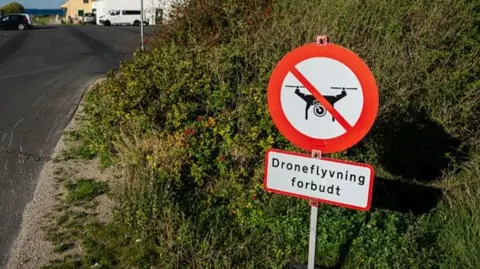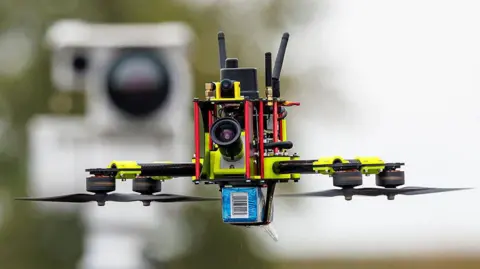Business
What’s the best way to detect and destroy drones?

Adrienne MurrayTechnology reporter
 AFP via Getty Images
AFP via Getty ImagesIn the northern Danish city of Aalborg, the firm MyDefence makes equipment that jams and repels drones.
“We’ve had a big surge of interest,” says chief executive, Dan Hermansen.
He says that up until early October his company was mainly dealing with defence firms, but now it has “completely shifted”.
The small, box-like kit made by MyDefence is mostly used by the military of Nato countries and Ukraine.
However lately demand has grown from civilian customers.
“It’s coming from critical infrastructure,” he adds, “from big companies, looking to protect their own assets”.
The device detects communication between the drone and its pilot, then breaks that connection, explains Mr Hermansen, by emitting a powerful radio signal on the same frequency.
Rather than falling out of the sky, the drone is pushed away and has a controlled landing. If it tries to reconnect to a GPS signal, that can be blocked too, he adds.
Mr Hermansen reckons that radio frequency jamming works against 80 to 90% of the drones that are flown.
 MyDefence
MyDefenceWhile forcing an unwanted drone to crash land is a good result, it’s essential to be able to detect it first.
“The first part is really about identification. And the second part is an interceptor system,” explains Kasper Hallenborg, director of The Maersk Mc-Kinney Moller Institute at University of Southern Denmark.
Identifying a drone is not so easy, points out Andreas Graae, the head of research at the Institute of Military Technology at the Danish Defence Academy.
“[Drones] can be very small or really big, and are often produced from materials like plastic or fabrics that are very hard to detect on a traditional radar,” he says.
A suite of technologies are under constant development, to help find drones.
That includes acoustic sensors that listen for the drone’s buzzing; advanced optical cameras, with very high resolution; and increasingly sophisticated tactical radars, which work over longer ranges and can even differentiate between a drone or a bird.
Once detected, a drone needs to be disabled. Electronic jamming, similar to that used by MyDefence has leapt forward, thanks in large part to the war in Ukraine.
“[Ukraine’s] frontlines are totally jammed,” Mr Graae says, which means that drone controllers lose control of their machines.
So, Russia and Urkaine have adapted by using drones controlled by fibre optic cables, or using drones that can navigate autonomously, or fly along pre-programmed routes.
Such drones need to be intercepted or shot down and plenty of firms are working on novel ways to do that.
Among them is Swedish start-up, Nordic Air Defence. It is developing a low-cost interceptor designed to strike the targeted drone, forcing it to crash.
“It’s missile shaped, so travels incredibly fast,” he adds. “It’s incredibly easy to manufacture. It is basically 3D printed,” says Jens Holzapfel, the company’s business director.
 AFP via Getty Images
AFP via Getty ImagesCost is a criticial factor in countering drones.
Last month, Nato Secretary-General Mark Rutte said: “It’s unacceptable to shoot down drones costing one or two thousand dollars with missiles that may cost half a million or even a million dollars.”
That’s been a big lesson from Ukraine, says Mr Graae. “It’s become a competition of how cheap you can actually make a drone attack, and how expensive it is to defend against.”
“As hostile drones become cheaper, it puts pressure on the defender to manufacture low cost products,” agrees Mr Holzapfel.
Low-cost drones are increasingly a security issue away from the frontlines of Ukraine.
Poland and Romania had their airspace breached by Russian drones; while separate drone incidents were reported, in Norway, Sweden, Lithuania, Romania and most recently at Germany’s Munich airport.
In Denmark tensions have also run high after a string of mysterious sightings at airports and military installations around the country.
That spurred the defence ministry to deploy “several capacities” that can detect, track and jam drones; and last week Sweden announced plans to invest more than $365m (£275m) in anti-drone systems, including measures to jam and shoot them down, as well as the deployment of hunter drones.
Mr Holzapfel at Nordic Air Defence currently works with Sweden and its European allies. As well as the military, clients are from law enforcement agencies and security companies.
But he also sees civilian sectors like shipping and the oil and offshore industries as potential markets.
 AFP via Getty Images
AFP via Getty ImagesIn a civilian setting. simply shooting down a drone might be too risky.
“It could be rather dangerous,” says Kasper Hallenborg, pointing to the falling parts and potentially flammable fuel.
“We saw the impact in Poland,” he continues. “That was just drone fragments, which more or less removed the roof of a house.”
Early detection would help, says Mr Hallenborg: “Then you can probably take it down somewhere it’s more safe to do so.”
At short ranges, shooting out nets to tangle up the drone is another method and cheap lasers are also being developed.
There are also safer, so-called soft-kill options, including hacking. “That’s a more secure way to neutralize the drone, because then you can actually control the landing,” says Mr Graae.
Crucially, a traffic management system is urgently needed, suggests Mr Hallenborg, involving electronic license plates for each drone device and way for users to register the flight in advance.
“Then we can quickly identify which drones are allowed to be there and those that aren’t,” says Mr Hallenborg.
“The [Danish] police have been overloaded with people telling them about what they’ve seen in the sky. A lot of these drones are probably there with a [legitimate] purpose,” he says.
Business
Fare relief move: Air India waives change, cancellation fees on domestic bookings after IndiGo disruption – The Times of India

Five days after widespread flight disruptions triggered by IndiGo cancellations, Tata Group-owned Air India on Saturday announced a special waiver on change and cancellation charges for eligible domestic bookings, aiming to offer relief to affected travellers, PTI reported.The airline said customers who booked tickets on Air India or its subsidiary Air India Express on or before December 4 for travel up to December 15 can make a one-time change or cancellation without paying the usual fee, provided the request is made by December 8, 2025. In case of rescheduling, any fare difference will still be applicable.
Under the waiver, passengers can either reschedule their journeys to a later date within the validity of the purchased ticket without paying rescheduling charges or cancel their bookings and receive a full refund, with no cancellation fee applied, the airline said.Air India also said it, along with Air India Express, has “proactively” capped economy-class airfares on non-stop domestic routes from December 4 to prevent price spikes driven by automated demand-supply algorithms. The carriers are also in the process of ensuring compliance with the latest directive issued by the Civil Aviation Ministry on airfare caps.
Business
Volkswagen capex recalibration: Automaker pares 2030 investment to $186 bn; China, US headwinds grow – The Times of India

Volkswagen Group plans to invest €160 billion ($186 billion) through 2030, a scaled-down outlay that reflects tightening capital allocation as Europe’s largest automaker grapples with mounting pressure in its two biggest markets — China and the United States, Reuters reported.The investment figure, announced by Volkswagen CEO Oliver Blume, is part of the company’s rolling five-year capital expenditure plan, which is updated annually. The latest commitment compares with €165 billion earmarked for 2025–2029 and €180 billion for 2024–2028, with 2024 marking the peak year for spending.Since that peak, the group — which houses brands such as Porsche and Audi — has been squeezed by higher costs and weaker margins, hit by US tariffs on imported vehicles and intensifying competition in China. The strain has been felt most acutely at Porsche, which derives nearly half of its sales from the US and China combined.Porsche recently unveiled a significant rollback of its electric vehicle strategy as profits came under pressure. Speaking to Frankfurter Allgemeine Sonntagszeitung, Blume said the focus of the latest investment plan was firmly “on Germany and Europe,” particularly in products, technology and infrastructure.Blume added that discussions on an extended savings programme at Porsche are expected to continue into 2026. He also said he does not expect Porsche to grow in China, though localising production across the wider Volkswagen group remains an option. A China-specific Porsche model could make sense at some point, he said.On Audi, Blume noted that any decision on building a manufacturing plant in the United States would depend on whether Washington offers substantial financial support.Blume, who will step down as Porsche CEO in January to concentrate fully on running Volkswagen Group, said his recent contract extension as Volkswagen chief executive until 2030 signalled continued backing from the Porsche and Piëch families as well as the German state of Lower Saxony, the company’s largest shareholders.“But it is true, of course, that shareholders have suffered losses since Porsche went public three years ago. I, too, must face up to this criticism,” he said.
Business
How IndiGo Managed To Hold A Country Of 1.4 Billion People Hostage, Forced Govt To Bend Rules | Analysis

At a time when most Indian airlines are posting losses, IndiGo stands out as the only profitable carrier. Yet, while loss-making airlines managed to comply with DGCA directives within the allotted 18-month period, the one airline turning a profit failed to do so. The DGCA had provided ample time for compliance and workforce planning. But while others focused on meeting regulatory requirements, IndiGo appeared to pursue a different strategy—creating disruption to pressure the government. Incredibly, this approach worked: instead of imposing penalties, the government chose to relax the norms.
Aviation expert Harsh Vardhan squarely called this entire crisis a failure of IndiGo’s management. He said this is an extremely unprecedented situation. Passengers have been suffering for three days, and this is the peak tourist, wedding, and business season. IndiGo’s claim that the new FDTL policy suddenly created problems is nothing but a management failure. The policy wasn’t introduced overnight—it was formulated over years of deliberation and was finalised a year ago.
Harsh Vardhan reminded that the soft launch of the FDTL took place on July 1, 2025, and it was fully implemented from November 1, 2025. Other operators like Air India and SpiceJet made timely adjustments, which is why no major crisis emerged there. What surprises him most is the timing—if the policy was effective from November 1, why did this sudden “rampage” begin only a month later, at the start of December?
“The Government of India has decided to institute a high-level inquiry into this disruption. The inquiry will examine what went wrong at Indigo, determine accountability wherever required for appropriate actions, and recommend measures to prevent similar disruptions in the future, ensuring that passengers do not face such hardships again,” said the Ministry of Civil Aviation in a statement.
No one knows what will come out of the inquiry but, interestingly, IndiGo got rewarded for its blackmailing, instead of getting punished as the government relaxed norms.
Due to the IndiGo induced turbulence, the airfare on key routes touched Rs 80,000 to Rs 90,000. IndiGo didn’t merely cancel flights—it brought the system to a standstill, grounding aircraft, showcasing its clout, and effectively challenging the government to respond. Instead of asserting its authority, the NDA government backed down and rolled back its own directive. Through deliberate mismanagement, the airline pushed the system toward chaos. The suspension of over a thousand IndiGo flights severely disrupted the economy, sending hotel prices and ticket fares on other airlines soaring.
“The central government has ordered a probe and refunds—but the question is: when the monopoly of private companies and the government’s silence come together, who will protect the common people? Who are you working for? The public or the interests of big corporate houses?” Former Delhi Dy CM Manish Sisodia rightly questioned the government.
Shockingly, a country of 1.4 billion people relies primarily on just two major domestic carriers—IndiGo and Air India. IndiGo’s dominance is so significant that even Leader of the Opposition Rahul Gandhi publicly criticised the government for its oversight failures. “IndiGo fiasco is the cost of this Govt’s monopoly model. Once again, it’s ordinary Indians who pay the price – in delays, cancellations and helplessness. India deserves fair competition in every sector, not match-fixing monopolies,” said Gandhi.
For two decades, successive governments have allowed major airlines to collapse instead of restructuring them under new ownership. Jet Airways and Kingfisher Airlines are prime examples: both could have been revived by removing problematic promoters, yet no institutional mechanism was activated. The pattern repeated itself with Go First. When three airlines vanish in a decade, it signals not merely corporate failures but a systemic unwillingness to safeguard competition and consumer interest, wrote Prashant Tewari, public policy expert, mentioned in a recent report in The Pioneer.
Today, IndiGo controls over half of India’s domestic aviation market, with the Air India group holding most of the remainder. Smaller airlines operate on the margins, too weak to influence pricing or service standards.
Tewari wrote that disappearance of three airlines within years show government’s failure of protecting competition and consumer interest.
This duopoly-like environment has suffocated passengers: airfares on busy domestic routes routinely exceed those for comparable distances in Europe, Southeast Asia, or even the United States. A two-hour flight within India can cost more than a four-hour international journey elsewhere.
“IndiGo airline fiasco shows that Modi govt is either incompetent or in collusion. In either case, India deserves better. People have never suffered so much,” said Former Delhi CM and AAP convener Arvind Kejriwal.
For years, India’s aviation sector has needed at least eight to ten robust operators to foster true competition, stabilise fares, and minimise disruptions. Instead, new entrants face steep barriers, licensing moves painfully slowly, and foreign carriers seeking expansion are hindered by outdated protectionist policies disguised as national security concerns. This refusal to liberalise the skies has turned India into one of the world’s most expensive domestic aviation markets.
According to Tewari, the duoploy ecosystem suits certain entrenched interests. With opaque decision-making, India’s aviation sector functions with minimal accountability, he opined.
Though the government’s UDAN scheme was launched to make air travel accessible to the common citizen, soaring fares have made flying increasingly unaffordable.
Besides opening new airports, the government must urgently liberalise the sector, encourage new domestic players, revive grounded airlines under competent management, and allow credible foreign carriers to compete under regulated conditions. Until then, Indian travellers will continue to pay excessively, learning the same harsh lessons again and again.
-

 Sports6 days ago
Sports6 days agoIndia Triumphs Over South Africa in First ODI Thanks to Kohli’s Heroics – SUCH TV
-

 Tech6 days ago
Tech6 days agoGet Your Steps In From Your Home Office With This Walking Pad—On Sale This Week
-

 Entertainment6 days ago
Entertainment6 days agoSadie Sink talks about the future of Max in ‘Stranger Things’
-

 Fashion6 days ago
Fashion6 days agoResults are in: US Black Friday store visits down, e-visits up, apparel shines
-

 Politics6 days ago
Politics6 days agoElon Musk reveals partner’s half-Indian roots, son’s middle name ‘Sekhar’
-

 Tech6 days ago
Tech6 days agoPrague’s City Center Sparkles, Buzzes, and Burns at the Signal Festival
-

 Sports6 days ago
Sports6 days agoBroncos secure thrilling OT victory over Commanders behind clutch performances
-

 Entertainment6 days ago
Entertainment6 days agoNatalia Dyer explains Nancy Wheeler’s key blunder in Stranger Things 5







